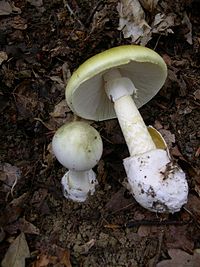
Characterization of fungi causing lesion blight on Papaver dubium in Iran
Sign Up to like & getrecommendations! Published in 2017 at "Antonie van Leeuwenhoek"
DOI: 10.1007/s10482-017-0966-8
Abstract: Papaver dubium (common name, blindeyes, Papaveraceae) is widespread throughout Europe and America and is an important weed in western Iran. Since 2009, a blight disease has occurred in several areas in Hamedan Province, Iran, causing… read more here.
Keywords: iran; characterization fungi; fungi causing; papaver dubium ... See more keywords

Pantoea: a newly identified causative agent for leaf blight disease in rice
Sign Up to like & getrecommendations! Published in 2019 at "Journal of Plant Diseases and Protection"
DOI: 10.1007/s41348-019-00244-6
Abstract: Leaf blight is one of the most serious threats to rice agroecosystems worldwide, and the yield reduction due to this disease can be as high as 70%. For decades, the disease has been reported to… read more here.
Keywords: pantoea; leaf blight; rice; disease ... See more keywords

Evaluation of tomato genotypes for early blight disease resistance caused by Alternaria solani in Pakistan
Sign Up to like & getrecommendations! Published in 2019 at "Journal of Plant Pathology"
DOI: 10.1007/s42161-019-00304-8
Abstract: Four hundred one tomato genotypes representing 11 species were screened against early blight (EB) disease caused by Alternaria solani in a net-house during 2013 to 2017. Considerable variation in resistance/susceptibility levels to EB was observed… read more here.
Keywords: early blight; tomato genotypes; resistance; disease ... See more keywords

Characterization of Macrophomina phaseolina associated with leaf blight disease on Chlorophytum borivilianum Santapau & R.R. Fern. and its fungicidal susceptibility
Sign Up to like & getrecommendations! Published in 2020 at "Journal of Applied Research on Medicinal and Aromatic Plants"
DOI: 10.1016/j.jarmap.2020.100288
Abstract: Abstract Safed musli, Chlorophytum borivilianum Santapau & R.R. Fern. is an important medicinal plant due to aphrodisiac and immuno-modulatory properties. Leaf blight disease showing characteristic symptom of necrosis spots on tips and outer margin of… read more here.
Keywords: chlorophytum borivilianum; leaf blight; macrophomina phaseolina; borivilianum santapau ... See more keywords

Desirable traits for a good biocontrol agent against fire blight disease.
Sign Up to like & getrecommendations! Published in 2023 at "Journal of applied microbiology"
DOI: 10.1093/jambio/lxad018
Abstract: AIMS This study aimed to improve the screening strategy for the selection of biocontrol agents with high biocontrol efficacy against fire blight disease. METHODS AND RESULTS A two-step screening procedure consisting of in vitro laboratory… read more here.
Keywords: blight disease; fire blight; desirable traits; biocontrol ... See more keywords

Characterization and Pathogenicity of Pestalotiopsis-Like Species Associated With Gray Blight Disease on Camellia sinensis in Anhui Province, China.
Sign Up to like & getrecommendations! Published in 2019 at "Plant disease"
DOI: 10.1094/pdis-02-19-0412-re
Abstract: Gray blight disease, caused by Pestalotiopsis-like fungi, is one of the deadliest threats to tea (Camellia sinensis) production. However, little information is known about the traits and characteristics of this pathogen. Here, a systematic survey… read more here.
Keywords: pathogenicity; pseudopestalotiopsis; sinensis; gray blight ... See more keywords

First Report of Stem and Leaf Blight Disease on Mesona chinensis Caused by Rhizoctonia solani in China.
Sign Up to like & getrecommendations! Published in 2022 at "Plant disease"
DOI: 10.1094/pdis-03-22-0457-pdn
Abstract: Mesona chinensis is an important medicinal and edible plant resource distributed in eight provinces in southern China. In December 2021, an unknown stem and leaf blight disease was found in M. chinensis cultivation areas in… read more here.
Keywords: chinensis; leaf blight; stem leaf; stem ... See more keywords

First report of Athelia rolfsii (=Sclerotium rolfsii) associated with southern blight disease of Macrotyloma uniflorum in India.
Sign Up to like & getrecommendations! Published in 2022 at "Plant disease"
DOI: 10.1094/pdis-12-21-2835-pdn
Abstract: Horse gram (Macrotyloma uniflorum (Lam.) Verdc., Fabaceae) is an important legume crop cultivated widely in the arid and semiarid regions. During a survey carried out in the Mysore district (Karnataka, India, October 2021), horse gram… read more here.
Keywords: rolfsii; disease; horse gram; macrotyloma uniflorum ... See more keywords

Spray-induced gene silencing as a potential tool to control potato late blight disease.
Sign Up to like & getrecommendations! Published in 2021 at "Phytopathology"
DOI: 10.1094/phyto-02-21-0054-sc
Abstract: Phytophthora infestans causes late blight disease on potato and tomato and is currently controlled by resistant cultivars or intensive fungicide spraying. Here, we investigated an alternative means for late blight control by spraying potato leaves… read more here.
Keywords: control; potato; late blight; potato late ... See more keywords

RAVL1 Activates Brassinosteroids and Ethylene Signaling to Modulate Response to Sheath Blight Disease in Rice.
Sign Up to like & getrecommendations! Published in 2018 at "Phytopathology"
DOI: 10.1094/phyto-03-18-0085-r
Abstract: Rhizoctonia solani causes sheath blight disease in rice; however, the defense mechanism of rice plants against R. solani remains elusive. To analyze the roles of brassinosteroid (BR) and ethylene signaling on rice defense to R.… read more here.
Keywords: rice; ethylene signaling; ravl1; sheath blight ... See more keywords

The Antifungal Activity and Mode of Action of a Streptomyces-Derived Anti-Microbial, Ningnanmycin, on the Tea Gray Blight Disease Pathogen Pseudopestalotiopsis camelliae-sinensis.
Sign Up to like & getrecommendations! Published in 2021 at "Phytopathology"
DOI: 10.1094/phyto-09-20-0382-r
Abstract: Gray blight disease is a serious disease of tea (Camellia sinensis (L.) Kuntz), for which there is currently no effective control or preventative measure apart from fungicides. Screening for effectiveness of a natural anti-microbial against… read more here.
Keywords: microscopy; anti microbial; sinensis; gray blight ... See more keywords